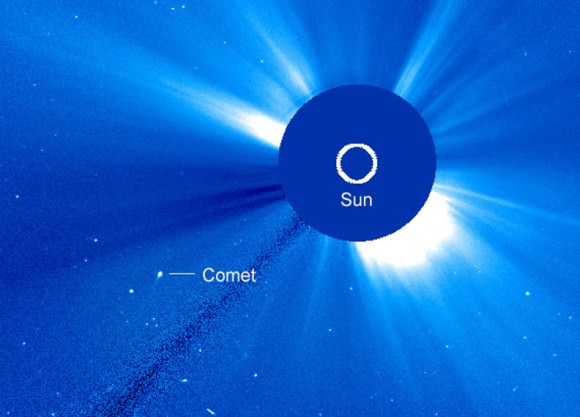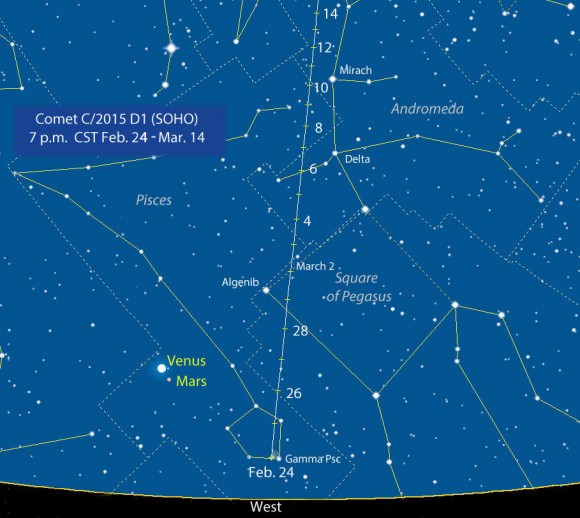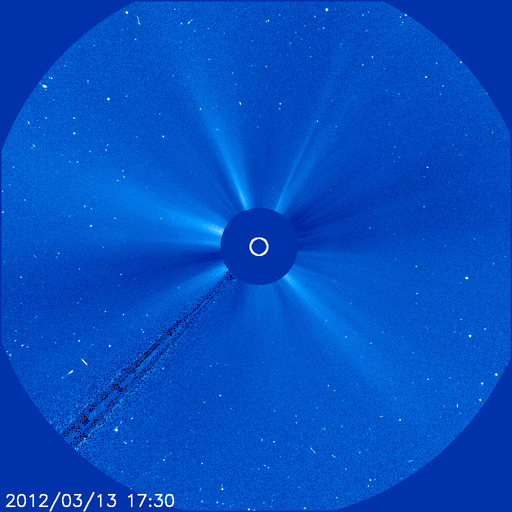A newly-discovered comet may soon become bright enough to see from a sky near you. Originally dubbed SOHO-2875, it was spotted in photos taken by the Solar and Heliospheric Observatory (SOHO) earlier this week. Astronomer Karl Battams, who maintains the Sungrazer Project website, originally thought this little comet would dissipate after its close brush with the Sun. To his surprise, it outperformed expectations and may survive long enough to see in the evening sky.

Most sungrazing comets discovered by SOHO are members of the Kreutz family, a group of icy fragments left over from the breakup of a single much larger comet centuries ago. We know they’re all family by their similar orbits. The newcomer, SOHO’s 2,875th comet discovery, is a “non-group” comet or one that’s unrelated to the Kreutz family or any other comet club for that matter. According to Battams these mavericks appear several times a year. As of today (Feb. 24) its official name is C/2015 D1 (SOHO).

What’s unusual about #2,875 is how bright it is. At least for now, it appears to have survived the Sun’s heat and gravitational tides and is turning around to the east headed for the evening sky. Before it left SOHO’s field of view on Feb. 21, the comet was still around magnitude +4-4.5.
No one can say for sure whether it has what it takes to hang on, so don’t get your hopes up just yet. Battams and others carefully calculated the comet’s changing position in the SOHO images and sent the data off to the Minor Planet Center, which today published an orbit.

Based on this preliminary orbit, I’ve plotted SOHO-2875’s path for the next couple weeks as it tracks up through Pisces and Pegasus during the early evening hours. Given that it’s probably no brighter than magnitude +6 at the moment and very low in the west at dusk, it may still be swamped in twilight’s glow.
Barring an unexpected outburst, there’s no question that the comet will fade in the coming days as its distance from both the Earth and Sun increase. Right now it’s 79 million miles from us and 28 million miles from the Sun. That puts it about 8 million miles closer to the Sun than the planet Mercury.

I drew up the chart for about 75 minutes after sunset in late twilight. Keep in mind that since the comet’s positions were determined via spacecraft imagery, which isn’t as precise as photographing it from ground observatories, its orbit is preliminary. That means it may not be on the precise path shown on the map. Be sure you search up-down and right-left of the plotted locations.
It’s also very possible the comet is in the process of disintegration after perihelion passage, so it may not be a dense, compact object but rather a diffuse cloud of glowing dust. Will it go the way of Comet ISON and fade away to nothing? Who knows? I sure don’t but can’t wait to find out what it’s up to the next clear night.
BTW, if you’ve got a software program that downloads orbital elements for comets to create your own charts, you’ll find the numbers you need in today’s Minor Planet Circular. Be sure to use the “post-perihelion” elements that predict the comet’s location from here on out.



